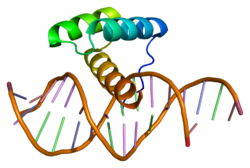MSX1
Msh homeobox 1, also known as MSX1, is a protein that in humans is encoded by the MSX1 gene. MSX1 transcripts are not only found in thyrotrope-derived TSH cells, but also in the TtT97 thyrotropic tumor, which is a well differentiated hyperplastic tissue that produces both TSHß- and a-subunits and is responsive to thyroid hormone. MSX1 is also expressed in highly differentiated pituitary cells which until recently was thought to be expressed exclusively during embryogenesis. There is a highly conserved structural organization of the members of the MSX family of genes and their abundant expression at sites of inductive cell–cell interactions in the embryo suggest that they have a pivotal role during early development.
This gene encodes a member of the muscle segment homeobox gene family. The encoded protein functions as a transcriptional repressor during embryogenesis through interactions with components of the core transcription complex and other homeoproteins. It may also have roles in limb-pattern formation, craniofacial development, in particular, odontogenesis, and tumor growth inhibition. There is also strong evidence from sequencing studies of candidate genes involved in clefting that mutations in the MSX1 gene may be associated in the pathogenesis of cleft lip and palate. Mutations in this gene, which was once known as homeobox 7, have also been associated with Witkop syndrome, Wolf-Hirschhorn syndrome, and autosomal dominant hypodontia. Haploinsufficiency of MSX1 protein affects the development of all teeth, preferentially third molars and second premolars. The effect of haploinsufficiency of PAX9 on the development of incisors and premolars is probably caused by a deficiency of MSX1 protein.
...
Wikipedia


